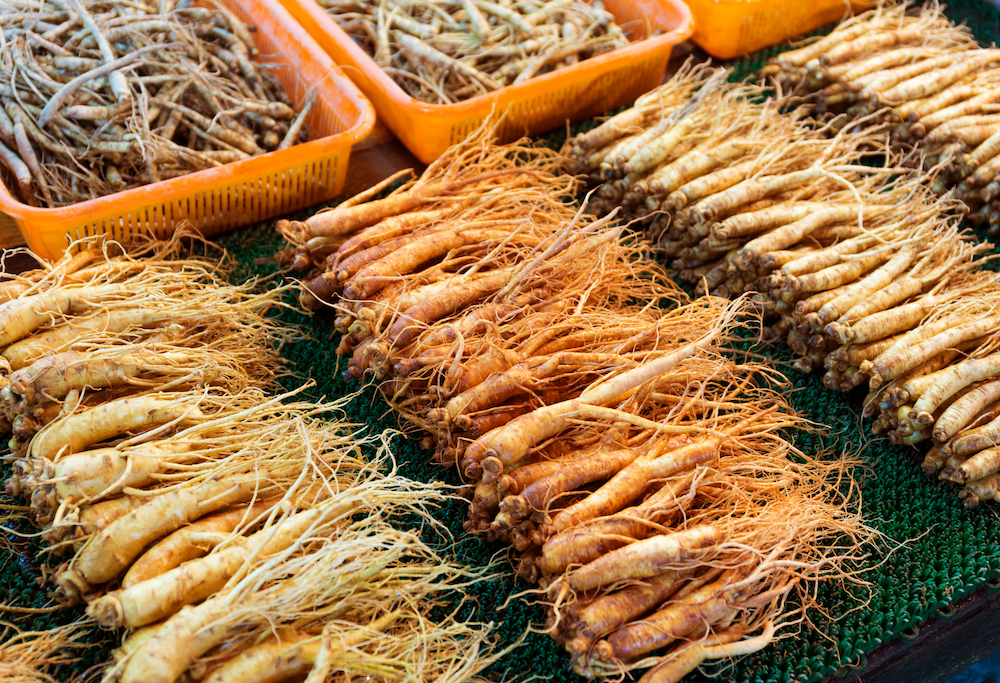In a recent article, we discussed adaptogens and their benefits for our holistic health. One of those adaptogens is a root also widely used within the practice of Traditional Chinese Medicine (TCM) – Korean red ginseng.
Korean red ginseng is an Asian medicinal plant known by multiple names: Asian ginseng, red Panax ginseng, and Chinese ginseng. It is known to have various medicinal properties, such as:
* vasodilation (widening of the blood vessels)
* antioxidant
* anti-cancer
How is Korean Red Panax Ginseng Grown?
Korean red ginseng grows in shady and moist mountain regions of Eastern Asia. It is approximately two feet tall and has dark green leaves and red berry clusters. The root is wrinkled and has a mildly sweet and bitter taste. The root should be grown to maturity (4-5 years) before it can be used for the best medicinal benefit. It is called white ginseng when the root is dried and not processed.
The root’s color changes when processed and dried further with heat, becoming red ginseng. Korean red ginseng offers unique bioactive properties, including heightened anti-inflammatory capability.
Ginseng in Traditional Medicine
Ginseng plant roots have been part of Chinese medicine for thousands of years. It was once rare and considered to have “mysterious” powers. Ginseng root is used to treat a broad spectrum of conditions and promote overall health and well-being. The most common ailments associated with ginseng treatments are fatigue, weakness, and male sexual dysfunction.
Here are the most beneficial ways that red ginseng root can promote comprehensive health:
Energy Boost: For those living with fatigue or weakness, ginseng can increase energy levels. A study revealed these effects by observing energy-boosting reactions in patients undergoing cancer treatment.
Mental Capacity: Research has shown that daily Korean ginseng intake for three months can improve the cognitive capability of Alzheimer’s patients. Oral ginseng also improves abstract thinking and mental skills in healthy middle-aged people. There is some evidence that a Panax ginseng and ginkgo leaf extract blend may enhance the memory of healthy adults.
COPD Relief: Research suggests that taking Korean red ginseng orally may help improve lung functions and help relieve the symptoms of chronic obstructive pulmonary disease (COPD).
Cold & Flu Prevention: Taking Panax ginseng may help minimize the risk of common cold or flu, but it does not appear to alleviate symptoms once the illness is contracted.
Erectile Dysfunction: Panax ginseng may help men with erectile dysfunction by improving blood flow to the sexual organs.
Multiple Sclerosis Fatigue: Similar to its anti-fatigue property with cancer patients, Panax ginseng may help reduce tiredness and improve the quality of life for women living with MS.
Reducing Blood Sugar Levels: Research points to Panax ginseng lowering blood sugar levels in diabetic patients. Ginsenosides in ginseng influence pancreatic insulin production and improve insulin resistance.
How to Take Korean Red Ginseng
Korean ginseng is commonly used as a dietary supplement, available in powder or capsule form. The average dose of Korean Panax ginseng as an herbal supplement is approximately 200 to 400 mg daily. Most experts recommend taking the supplement on a two-week on/two-week off rotation, as ginseng buildup in the body can cause a toxic reaction.
Although considered generally safe, if you want to add a ginseng supplement to your dietary routine, it is best to consult a certified nutritionist or medical professional. At Longevity Wellness Clinic, we specialize in helping people find their optimum health through natural and holistic means. Call us today for more information.



